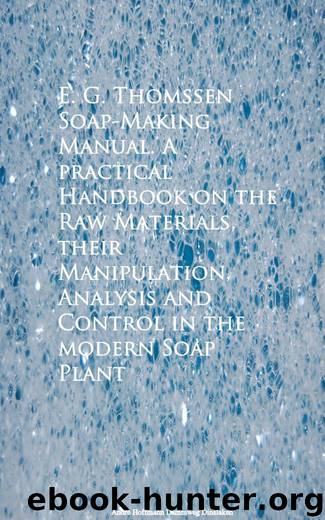Soap-Making Manual. A practical Handbook on the Raw Materials, their Manipulation, Analysis and Control in the modern Soap Plant by E. G. Thomssen

Author:E. G. Thomssen [Thomssen, E. G.]
Language: eng
Format: epub
Published: 2016-07-30T00:00:00+00:00
3.25
lbs.
18° B.
hydrochloric
(muriatic)
acid
are
required.
2.92
"
20° B.
"
"
"
"
"
2.58
"
22° B.
"
"
"
"
"
For 1 pound of caustic soda—
1.93
lbs.
50° B.
sulphuric
acid
are
required.
1.54
"
60° B.
"
"
"
"
1.28
"
66° B.
"
"
"
"
It is, of course, feasible to neutralize the spent lye without first determining the causticity by titrating a sample and this is often the case. The operator under such conditions first adds the sulfate of alumina, then the acid, using litmus paper as his indicator. Comparatively, this method of treatment is much slower and not as positive, as the amount of acid or alkali to be added is at all times uncertain, for in the foaming of the lyes their action on litmus is misleading.
After the lye has been filtered to the filtered lye tank it is fed to the evaporator, the method of operation of which varies somewhat with different styles or makes. When it first enters the evaporator the lye is about 11°-12° B. After boiling the density will gradually rise to 27° B. and remain at this gravity for some time and during which time most of the salt is dropped out in the salt filter. As the lye concentrates the gravity gradually rises to 28°-30° B., which is half crude glycerine and contains about 60 per cent. glycerine. Some operators carry the evaporation to this point and accumulate a quantity of half crude before going on to crude. After half crude is obtained the temperature on the evaporator increases, the vacuum increases and the pressure on the condensation drain goes up (using the same amount of live steam). As the liquor grows heavier the amount of evaporation is less, and less steam is required necessitating the regulation of the steam pressure on the drum. When a temperature of 210° F. on the evaporator, with 26 or more inches vacuum on the pump is arrived at, the crude stage has been reached and the liquor now contains about 80 per cent. glycerine in which shape it is usually sold by soap manufacturers. A greater concentration requires more intricate apparatus. After settling a day in the crude tank it is drummed.
Crude glycerine (about 80 per cent. glycerol) free from salt is 33° B., or has a specific gravity of 1.3. A sample boiled in an open dish boils at a temperature of 155° C. or over.
Download
This site does not store any files on its server. We only index and link to content provided by other sites. Please contact the content providers to delete copyright contents if any and email us, we'll remove relevant links or contents immediately.
On Writing A Memoir of the Craft by Stephen King(4221)
The Doodle Revolution by Sunni Brown(4051)
A Simplified Life by Emily Ley(3581)
Mummy Knew by Lisa James(3174)
Marijuana Grower's Handbook by Ed Rosenthal(3126)
Paper Parties by Erin Hung(3046)
Better Homes and Gardens New Cookbook by Better Homes & Gardens(2962)
Figure Drawing for Artists by Steve Huston(2804)
Draw Your Day by Samantha Dion Baker(2714)
The Genius of Japanese Carpentry by Azby Brown(2616)
Japanese Design by Patricia J. Graham(2562)
Lions and Lace by Meagan Mckinney(2496)
Dangerous Girls by Haas Abigail(2481)
The Curated Closet by Anuschka Rees(2393)
Zero to Make by David Lang(2349)
How to Make Your Own Soap by Sally Hornsey(2345)
The Wardrobe Wakeup by Lois Joy Johnson(2238)
The Code Book by Simon Singh(2218)
The Checklist Manifesto by Atul Gawande(2208)
